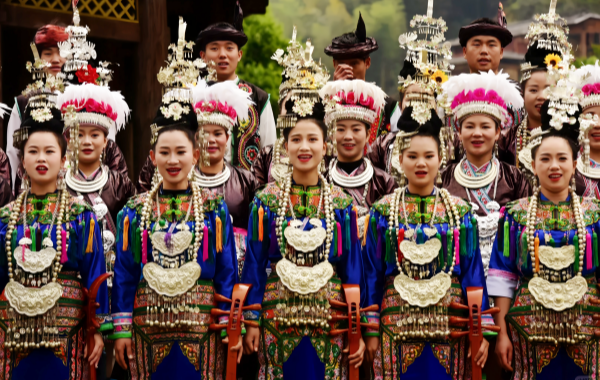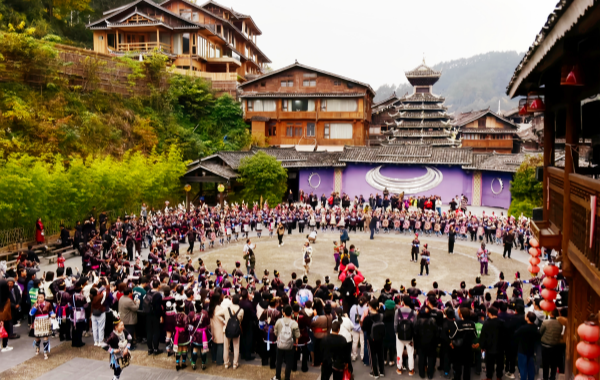Dong
Introduction

The Dong Nationality is a unique and vibrant ethnic group in China, known for its rich cultural heritage, beautiful architecture, and melodious music. With a long - standing history, the Dong people have developed a distinct way of life that reflects their close relationship with nature and their strong sense of community. Their cultural traditions have been passed down through generations, contributing to the diversity and richness of Chinese culture.
 History
History
· Origin
The Dong people are believed to have descended from the ancient Baiyue tribes. Over time, they gradually migrated and settled in the mountainous regions of Southwest and Central - South China. Through interactions with neighboring ethnic groups, they formed their own unique cultural identity.
· Development
In history, the Dong people mainly engaged in agriculture, developing advanced farming techniques suitable for the hilly terrain. They built terraced fields, which not only increased arable land but also prevented soil erosion. The Dong society was organized in a relatively self - sufficient manner, with villages playing a central role in social and economic activities. They also had their own traditional governance systems within the villages.
· Modern Times
In modern times, the Dong people have witnessed significant social and economic changes. With the development of transportation and communication, they have had more contact with the outside world. The government has implemented a series of policies to support the development of ethnic minority areas, improving the living standards of the Dong people. At the same time, efforts have been made to preserve and promote Dong culture, including language, music, and architecture.
 Population
Population
· Quantity
As of the latest census data, the Dong population in China is approximately 3.5 million, making them one of the larger ethnic minorities in the country.
· Distribution
The Dong people are mainly concentrated in Guizhou Province, especially in the southeastern part, such as Liping, Congjiang, and Zhenyuan counties. There are also significant Dong communities in Tongdao Dong Autonomous County in Hunan Province and Sanjiang Dong Autonomous County in Guangxi Zhuang Autonomous Region. Their distribution is closely related to the geographical environment, with most villages located in mountainous areas with fertile soil and abundant water resources.
 Economy
Economy
Traditionally, the Dong economy was based on agriculture. The Dong people were skilled in growing rice, corn, and other crops on terraced fields. They also raised livestock such as cattle, pigs, and chickens. In addition to agriculture, forestry and fishing were important economic activities. The forests provided timber, fuel, and various non - timber forest products, while the rivers and streams were rich in fish.
In modern times, the Dong economy has diversified. Many Dong people are now involved in industries such as textiles, handicrafts, and tourism. The unique Dong architecture, music, and costumes have attracted a large number of tourists, providing new sources of income for the local people. At the same time, the development of modern agriculture, such as the cultivation of high - value crops and the use of advanced farming technologies, has also improved agricultural productivity.
 Culture
Culture
· Language and Script
The Dong language belongs to the Kam - Tai branch of the Tai - Kadai language family. It has several dialects. Although the Dong people did not have a widely - used written script in the past, they have a rich oral tradition. In recent years, the government has promoted the use of the Chinese character - based Dong script to help preserve and transmit Dong culture.
· Religious Beliefs
Polytheism is the main religious belief of the Dong people. They worship a variety of gods, including nature gods (such as the sun, moon, and mountains), ancestor gods, and village gods. These gods are believed to protect the village, ensure good harvests, and bring good luck to the people. In addition to polytheism, Buddhism, Taoism, and Confucianism have also had some influence on Dong religious beliefs and practices, especially in terms of moral and ethical concepts.
· Clothing
Traditional Dong clothing is colorful and distinctive. Women's clothing often features bright colors such as blue, purple, and black, with elaborate embroidery and silver ornaments. The embroidery patterns are usually inspired by nature, such as flowers, birds, and butterflies, reflecting the Dong people's love for beauty and nature. Men's clothing is relatively simple, usually consisting of a short - sleeved or long - sleeved shirt and trousers, often paired with a headscarf.
· Literature
Dong literature has a rich oral tradition, including folk songs, legends, and stories. Folk songs are an important part of Dong culture, covering a wide range of topics such as love, labor, and history. These songs are passed down from generation to generation through oral transmission, and they are often sung during festivals, weddings, and other social gatherings. Legends and stories reflect the Dong people's beliefs, values, and historical experiences, providing insights into their cultural heritage.
· Transportation
In the past, due to the mountainous terrain, the Dong people mainly relied on walking and horses for transportation within the villages and between villages. They also built wooden bridges across rivers and streams to facilitate communication. In modern times, with the development of infrastructure, roads have been built in many Dong - inhabited areas, and motorcycles, cars, and buses have become common means of transportation. However, traditional wooden bridges are still preserved as cultural landscapes and tourist attractions.
 Science
Science
· Medicine
Traditional Dong medicine is based on a combination of herbal remedies and spiritual practices. Dong healers have extensive knowledge of local herbs and their medicinal properties. They use these herbs to treat various diseases, often accompanied by rituals and prayers to invoke the help of gods. In recent years, there has been growing interest in integrating traditional Dong medicine with modern healthcare systems to provide more comprehensive medical services for the Dong people.
· Calendar
The Dong people have their own traditional calendar, which is based on the lunar cycle and agricultural seasons. The calendar is used to guide farming activities, such as when to plant and harvest crops. It also marks important cultural events and festivals, helping the Dong people to maintain their cultural traditions and sense of time.
 Art
Art
· Music
Dong music is famous for its beautiful melodies and unique vocal styles. The most well - known form of Dong music is the grand chorus, which can involve hundreds of singers. The chorus is characterized by its multi - voice harmony and rich timbre, creating a magnificent and moving musical effect. Traditional Dong musical instruments include the lusheng (a reed - pipe wind instrument), the niuhong (a wooden drum), and various types of flutes. Dong songs often express the people's emotions, such as love, joy, and sorrow, and reflect their life experiences and cultural values.
 · Dance
· Dance
Dong dance is lively and expressive, with movements that are closely related to daily life and work. Traditional Dong dances include the lusheng dance, which is performed while playing the lusheng, and the farming dance, which mimics farming activities. These dances are often performed during festivals and celebrations, bringing people together in a joyful atmosphere. Dancers wear colorful costumes and perform with enthusiasm, showcasing the Dong people's artistic talents and cultural vitality.
· Architecture
Dong architecture is renowned for its unique style and exquisite craftsmanship. The most iconic Dong architectural structure is the drum tower. Drum towers are tall, multi - storied wooden buildings that serve as the center of village life. They are used for meetings, celebrations, and as a place to store drums for signaling. Another characteristic Dong building is the wind - rain bridge, which combines the functions of a bridge and a pavilion. These bridges are often decorated with beautiful carvings and paintings, reflecting the Dong people's aesthetic sense and architectural skills.
· Landscape
The Dong - inhabited areas are characterized by beautiful natural landscapes, including mountains, rivers, and forests. The terraced fields built by the Dong people on the hillsides are not only a marvel of agricultural engineering but also a beautiful scenic spot. The clear rivers and streams winding through the villages add to the charm of the landscape. This natural beauty has inspired many Dong artists and poets, who have created numerous works of art that celebrate the beauty of their homeland.
· Arts and Crafts
Dong arts and crafts are known for their fine workmanship and unique designs. Traditional Dong crafts include embroidery, batik, wood - carving, and silver - making. Dong embroidery is famous for its delicate patterns and bright colors, often used to decorate clothing and household items. Batik is a traditional dyeing technique that creates beautiful patterns on fabric. Wood - carving is used to decorate buildings, furniture, and religious objects, while silver - making produces exquisite jewelry and ornaments. These crafts are not only important cultural symbols but also provide economic income for the Dong artisans.
 Custom
Custom
· Etiquette
Dong etiquette is based on respect, hospitality, and harmony. When visiting a Dong home, guests are usually greeted with warm smiles and offered tea or wine. It is customary to accept these offerings as a sign of respect for the host. The Dong people also place great importance on greetings and polite language. When meeting elders or guests, young people should show proper respect, such as bowing slightly or using formal titles.
· Marriage Customs
Dong marriage customs are rich in tradition and ritual. Marriages are often arranged by the families of the bride and groom, but the consent of the couple is also important. The wedding ceremony is a grand event that involves several steps, including engagement, dowry delivery, and the wedding feast. During the ceremony, there are various traditional rituals, such as crossing the fire - bowl and drinking the cross - cupped wine, which symbolize the union of the couple and the blessing of the ancestors.
· Festivals
The Dong people celebrate many important festivals throughout the year. The Grand Song Festival is one of the most significant, held annually to showcase the Dong's grand chorus and traditional culture. During the festival, people from different villages gather together to sing, dance, and participate in various activities. Other festivals include the Spring Festival (Chinese New Year), the Dragon Boat Festival, and the Mid - Autumn Festival, which are celebrated in a similar way to the Han Chinese but with some unique Dong customs and traditions.
· Diet
Dong cuisine is characterized by its fresh ingredients and unique flavors. Staple foods include rice and corn, and common dishes include sour fish, smoked meat, and various vegetable dishes. The Dong people have a tradition of making sour and spicy foods, which help to preserve food and add flavor. They also like to drink homemade rice wine, which is often served during festivals and social gatherings.
· Funeral Customs
Dong funeral customs are based on respect for the deceased and the belief in an afterlife. When a person dies, the family will hold a series of funeral rituals, including washing the body, dressing it in new clothes, and placing it in a coffin. Shamans or elders will perform prayers and rituals to guide the soul of the deceased to the afterlife. Family and friends will gather to pay their respects and offer condolences, and a funeral feast is held to honor the memory of the deceased. The mourning period varies depending on the relationship with the deceased, and relatives and friends will continue to offer support to the bereaved family during this time.
What Our Clients Say?
Based on 10,000+ traveler reviews











